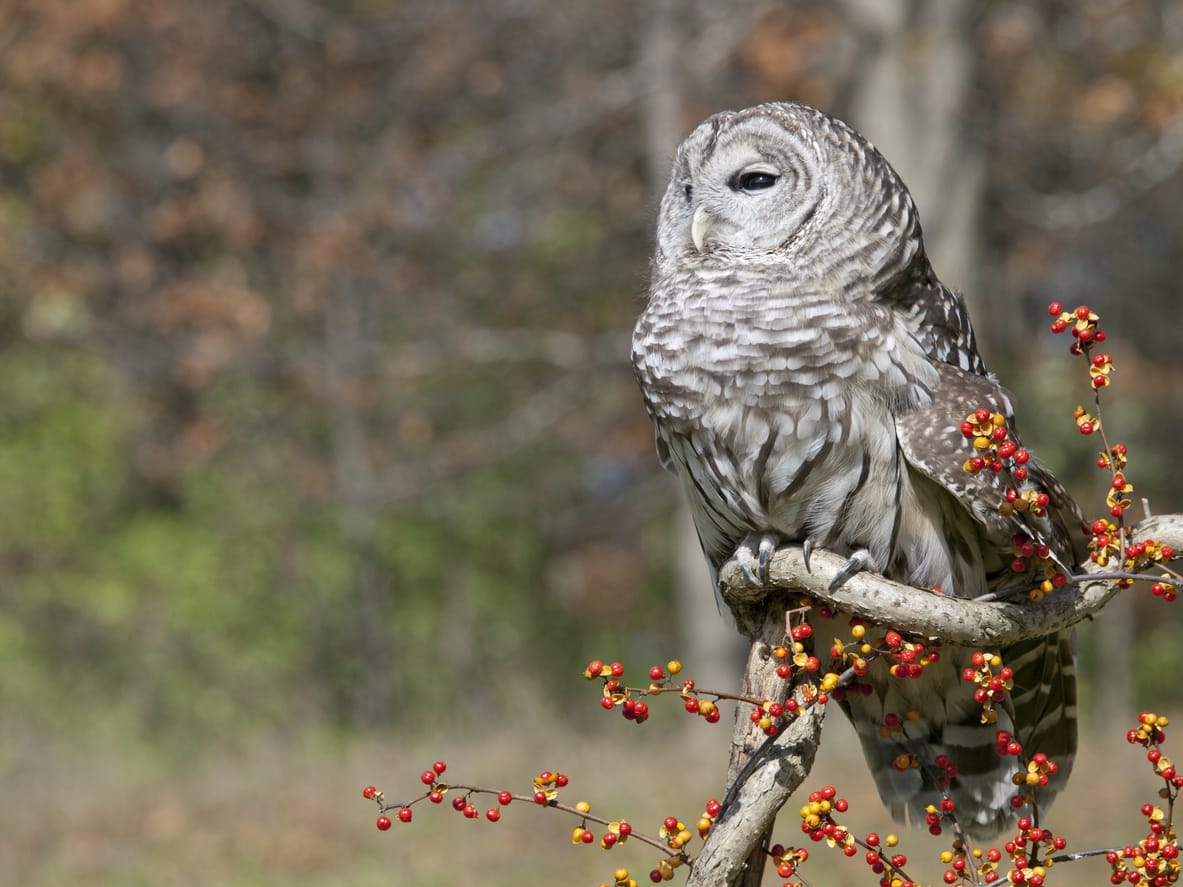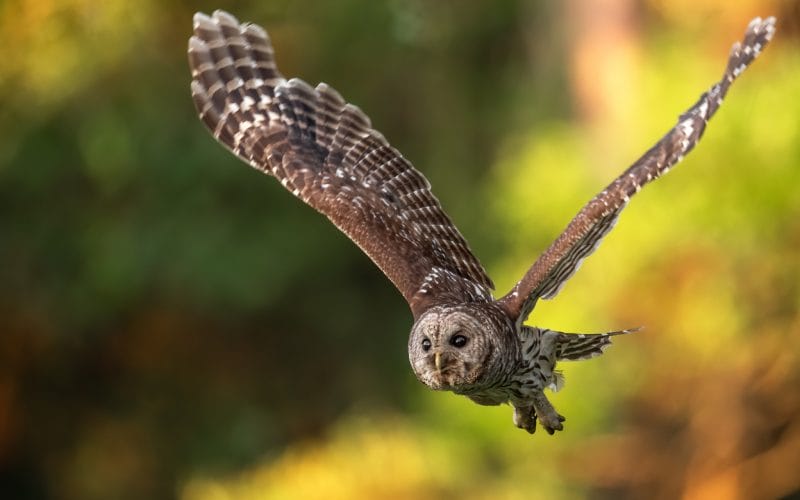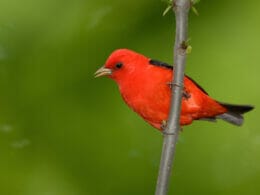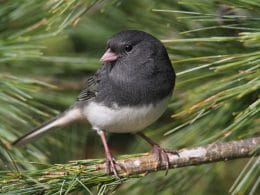Did you know that there are over 225 different species of owls in the world?
One would think there’s not much to know about owls. But, in reality, owls are fascinating creatures. They come in so many different sizes, colors, and shapes. Not to mention that they have various preferences regarding their habitat and eating habits.
Today, our focus will be on the owls in South Carolina. We’ll discuss everything related to those birds including the size, scientific name, habitat, and other interesting facts. You’ll be surprised to know how each one of them has at least one distinctive thing!
1. Barred Owl

- Scientific name: Strix Varia
- Length: 16.9-19.7 inches
- Weight: 16.6-37.0 ounces
- Wingspan: 39.0-43.3 inches
We kicked off our list with Barred Owls because they’re the most commonly seen in South Carolina. The reason behind this is that they’re “crepuscular.”
This word means that they are active in the twilight hours of dusk and dawn. This is usually when most people are outdoors.
Barred Owls can be seen all year in South Carolina, mostly in forests and swamps. They rest in tree cavities during the day and come out to hunt at night.
Author Note: Barred Owls got their name from their breast markings. They’re usually a mix of white and brown feathers that give out a barred pattern.
Residents of South Carolina are so used to the Barred Owls calls that they translated it in their own way. The recognizable call goes like “who-who-who-who, who-who-who- whoo hwa.” People translated that into “who-cooks-for-you, who-cooks-for-you all.”
However, not all the calls of Barred Owls are kicks and giggles. Their mating calls are a different story.
Some people reported that Barred Owls in mating seasons sound like humans screaming in agony. If you’re new to the state of South Carolina, you might have a few sleepless nights because of this.
Barred Owls feed on mice, rodents, reptiles, and small birds.
2. Great Horned Owl
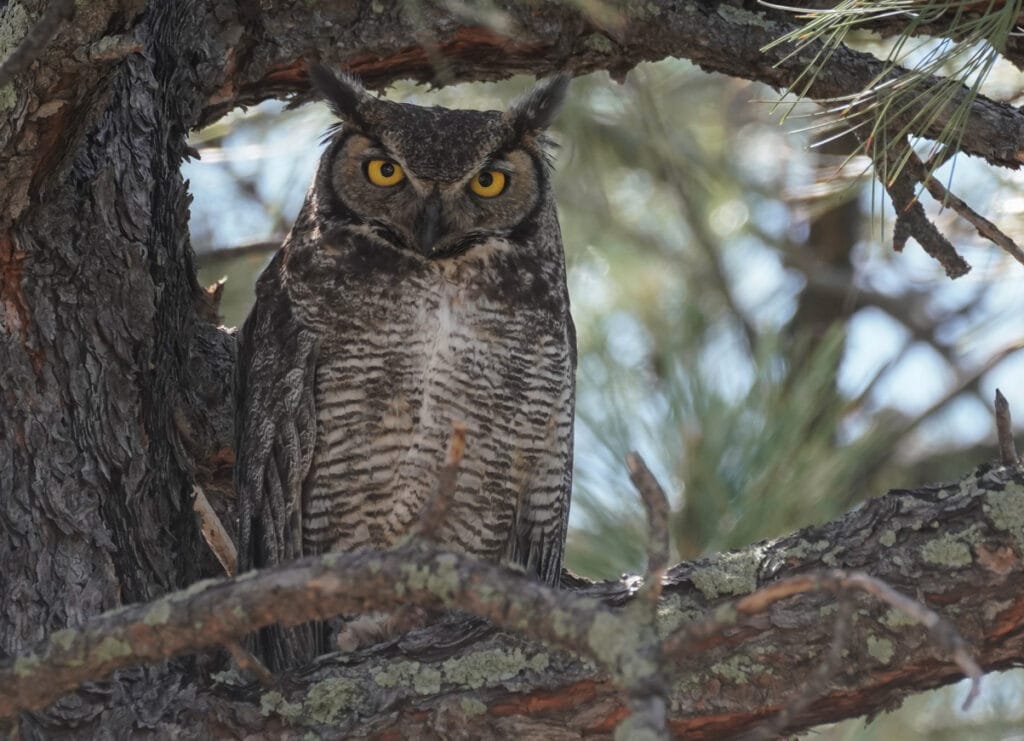
- Scientific name: Bubo Virginianus
- Length: 18.1-24.8 inches
- Weight: 32.1-88.2 ounces
- Wingspan: 39.8-57.1 inches
With a wingspan of almost 60 inches, Great Horned Owls are the largest and the heaviest in South Carolina.
Their iconic ear tufts make them the quintessential storybook owls. Add the large, yellow, cat-like eyes and the mean-looking forehead to the mix; and you got yourself a spooky owl.
Great Horned Owls have large chunky bodies that are covered with a mix of gray and brown feathers. Much like Barred Owls, these owls can be seen at any time of the year.
These owls don’t only look ferocious, but they’re also very capable and scary hunters. They soar towards their prey and snatch it with their large sharp talons.
Normally, Great Horned Owls feed on rodents, insects, and other small animals. But when the situation calls for it, they could take down more challenging animals like porcupines, crows, and other owls.
If you think this isn’t impressive enough, Great Horned Owls occasionally take down falcons. That’s right! These owls are not afraid to pick a fight with the bigger guys when they have to.
3. Northern Saw-whet Owl
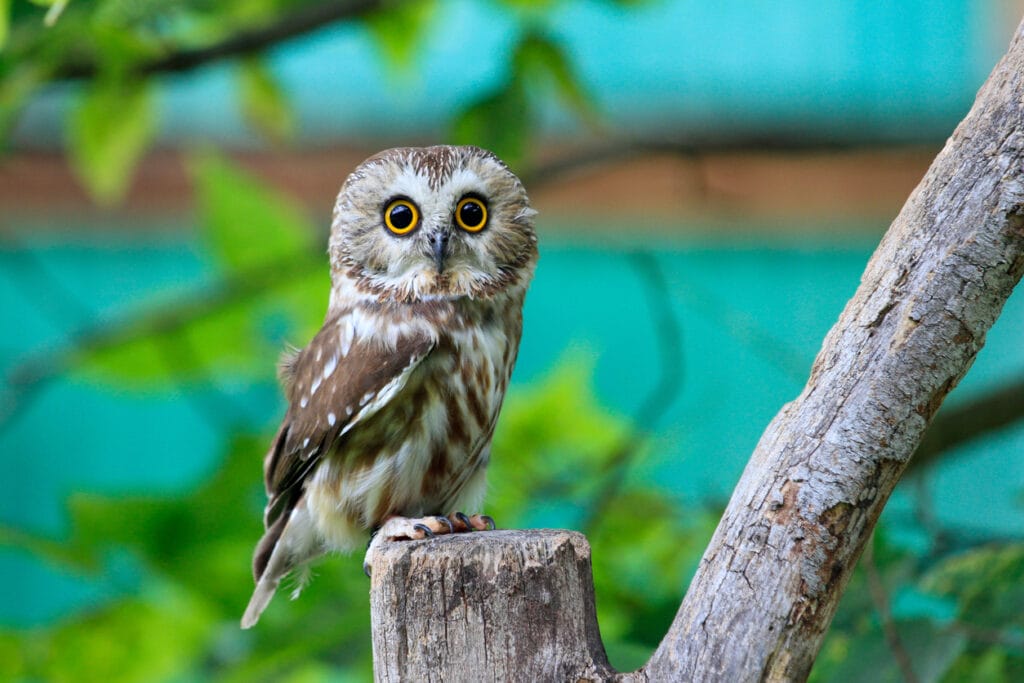
- Scientific name: Aegolius acadicus
- Length: 7.1-8.3 inches
- Weight: 2.3-5.3 ounces
- Wingspan: 16.5-18.9 inches
Northern Saw-whet Owls are the tiniest owls you could see in South Carolina. They have the size of a robin with large round heads and iconic yellow eyes.
They’re a rare sight. In fact, they’re only sighted in South Carolina during the winter where they perch on high trees to stay hidden. They’re more commonly found in Southern Canada where they breed.
When it gets too cold in winter, they migrate to South Carolina where it’s a lot warmer.
The call of Northern Saw-whet Owls is a distinct “toot-toot-toot” noise. It sounds like a hand saw being sharpened on a whetting stone. This is actually why they got the name “Saw-whet.”
Author Note: The low-pitched “toot-toot” in the woods is similar to what frogs sound like. This may be the sound that people hear during late spring and confuse for Saw-whet Owls.
The small size of these owls makes them hard to spot by both humans and other predators. They like to quietly roost in trees during the day.
Sometimes they’re ganged upon by songbirds after which a ruckus occurs that forces the owl to leave.
4. American Barn Owl

- Scientific name: Tyto Alba
- Length: 12.6-15.8 inches
- Weight: 14.1-24.7 ounces
- Wingspan: 39.4-49.2 inches
American Barn Owls are the most widely-distributed nocturnal birds in the world. Sometimes they’re known as common Barn Owls. Barn Owls are the most urbanized owls in South Carolina, and they look considerably different from other owls.
They have heart-shaped faces, long legs, white breasts, and tank backs. Their eyes also aren’t as yellow as you’d expect from your usual owl. Instead, they have dark beady eyes.
Unlike most owls, they don’t like to nest in trees very much. They’re mostly seen in abandoned buildings, church steeples, and barns. It’s how they got the name “Barn Owls.”
They also don’t hoot like most owls, but they make a hissing or a snoring sound that might be terrifying if you don’t know where it’s coming from.
If you own a farm and you spot a few Barn Owls around, don’t chase them away. They play a great role in ridding you of rodents, mice, and small mammals.
5. Eastern Screech-Owl
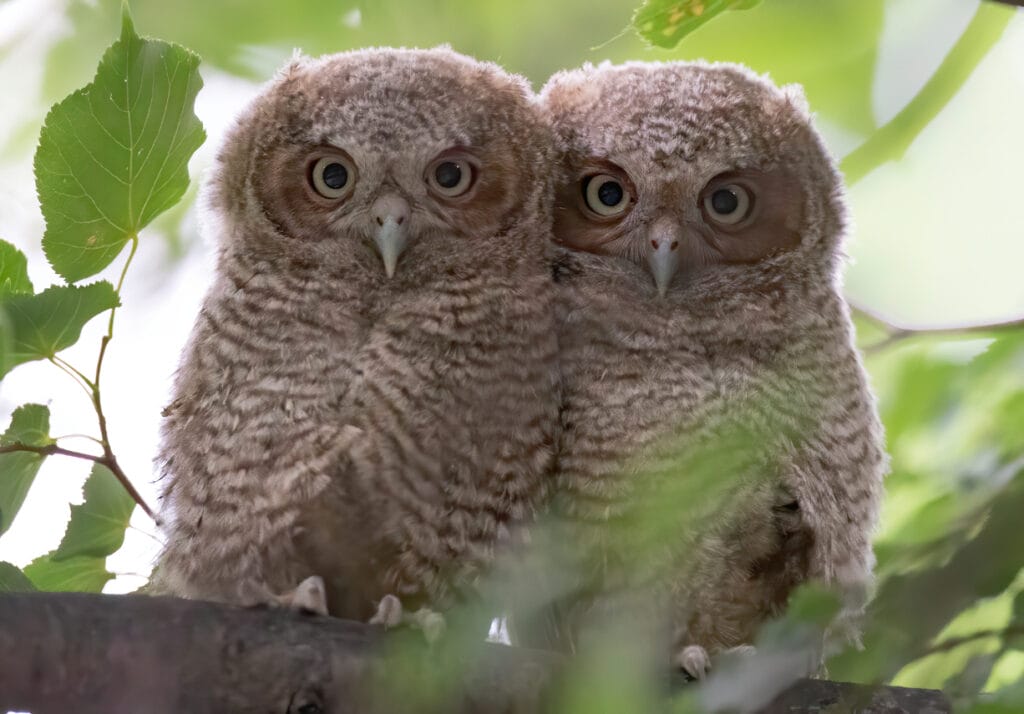
- Scientific name: Otus Asio
- Length: 6.3-9.8 inches
- Weight: 4.3-8.6 ounces
- Wingspan: 18.9-24.0 inches
Eastern Screech-Owls look like small versions of the Great Horned Owls, but they’re only slightly larger than a Blue Jay.
The resemblance to Great Horned Owls comes from the yellow eyes and the ear tufts. However, Eastern Screech-Owls don’t look as ferocious. They have white bellies, and the rest of their body is covered with speckled gray feathers.
This gives them great camouflage on the trees. If you live in South Carolina, you might have walked right past one without even noticing.
Although Eastern Screech-Owls could be seen any time of the year, they’re not commonly seen. This is probably due to their small size and camouflaged pattern.
They’re best spotted at night when you hear their distinctive calls. They have two; one is a high-pitched descending whine, the other is a warbling tone that sounds like a hissing whistle.
Top Tip: Some travelers carry taped recordings of these calls as they seem to attract various types of songbirds.
If you want to find Eastern Screech-Owls during the day, look for small collections of pellets near the tree bases.
These pellets are the regurgitated remains of food that the owls couldn’t chew. If you spot these pellets, check the nearby trees. You might be lucky enough to spot one of these owls.
6. Short-eared Owl
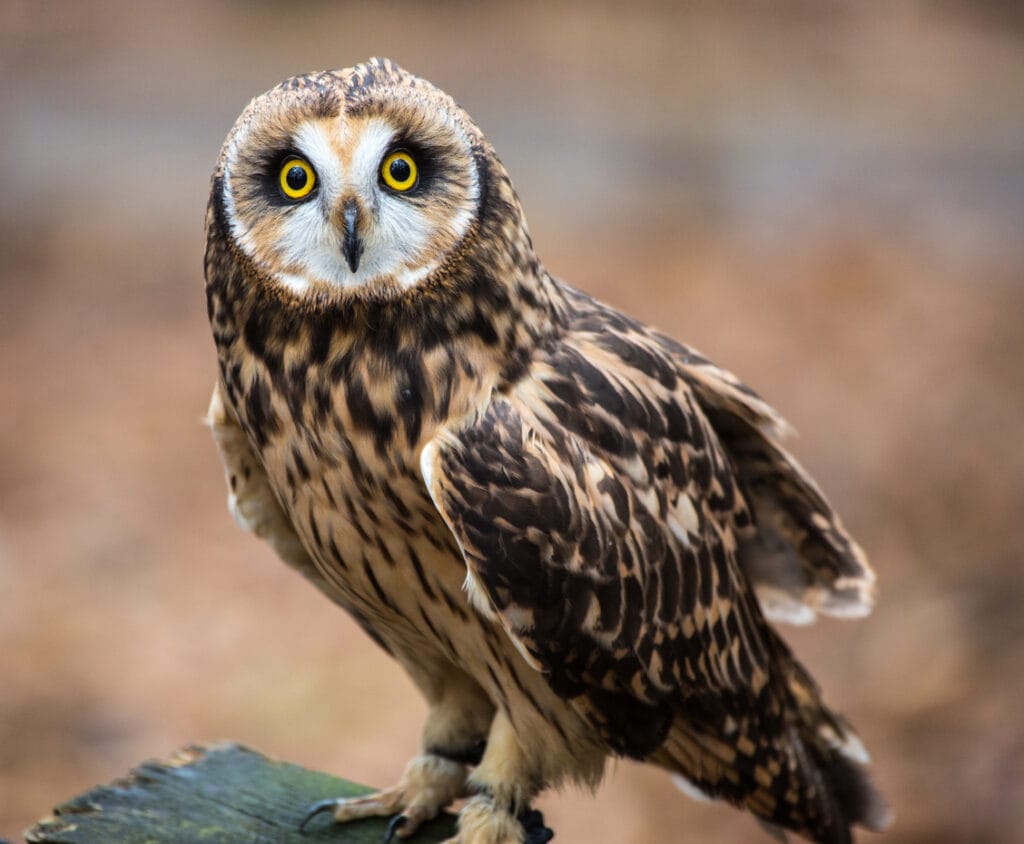
- Scientific name: Asio Flammeus
- Length: 13.4-16.9 inches
- Weight: 7.3-16.8 ounces
- Wingspan: 33.5-40.5 inches
Short-eared Owls are not common to see in South Carolina. They’re only sighted during winter and even then, it’s uncommon to find them. If you’re lucky enough to stumble upon them, they’re often in prairies or grasslands as they prefer open spaces.
Like most other owls, they have large yellow eyes, big round heads, and short necks. They also have a dark ring around their eyes and short tufts on their heads that are usually hard to see.
That’s how they got the name “Short-eared Owls.” When scared or threatened, these owls try to show their tufts to look ferocious.
The body is medium-sized and is usually covered with brown speckled feathers.
Short-eared Owls don’t like nesting on trees like other owls. They’re often perched low on trees or even sitting on the ground.
They’re also most active during the day. Look for them around dusk or dawn times because that’s when they hunt for rodents and insects.
7. Long-eared Owl
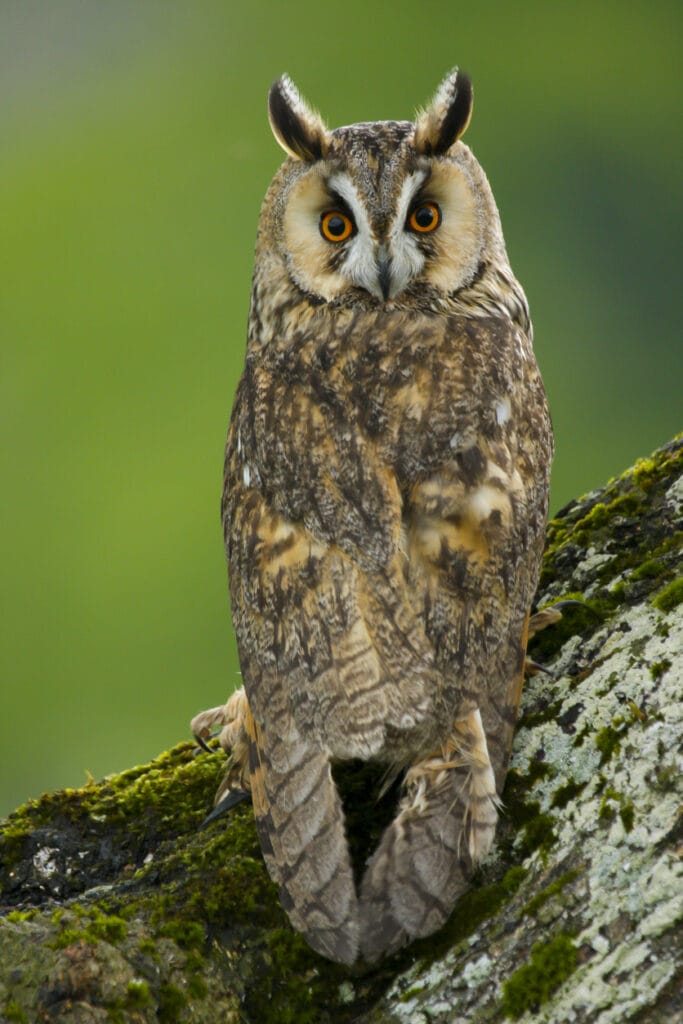
- Scientific name: Asio Otus
- Length: 13.8-15.8 inches
- Weight: 7.8-15.3 ounces
- Wingspan: 35.4-39.4 inches
Long-eared Owls are a rare sight in North Carolina. They’re also only seen in winter, which makes them even more scarce.
They also hardly release calls as often as other owls. When they do, it’s only in mating seasons and it sounds like a soft deep hoot or a whistle. The lack of calling makes it easy to walk past them without noticing.
In addition to the usual yellow eyes, Long-eared Owls have long tufts that resemble Great Horned Owls. However, they’re a lot smaller; almost the size of a crow. They also have square-shaped heads and they don’t look as mean as Great Horned Owls.
Top Tip: Typically, these owls have a mix of white and black feathers all over their bodies.
Long-eared Owls are mostly active at night. They find shelter in branches and use their sharp vision to hunt rodents and mice.
8. Burrowing Owl
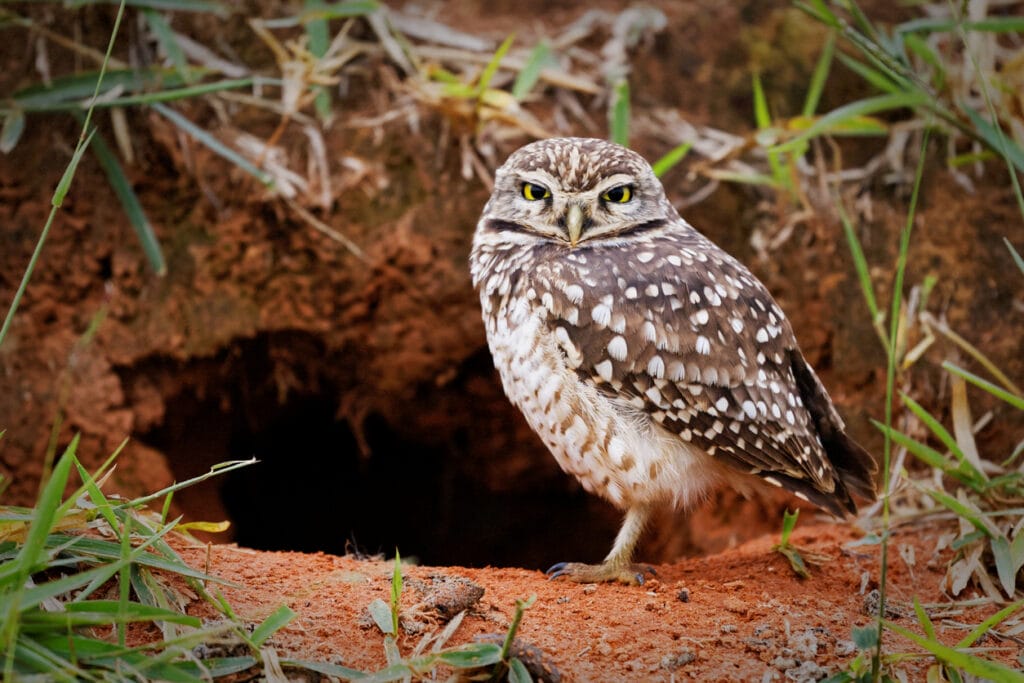
- Scientific name: Athene Cunicularia
- Length: 7.5-9.8 inches
- Weight: 5.3-5.8 ounces
- Wingspan: 20.2-23.8 inches
Burrowing Owls are best described as unique. These owls are active during the day and night. In the morning, they feed on insects. At night, they hunt rodents and small mammals in the dark.
These owls have yellow eyes, prominent white eyebrows, and white chins. Their bodies are small and slender. The heads lack tufts and their beaks are small and pointy.
Burrowing Owls rely on small mammals like squirrels and prairie dogs to create their shelters and hiding spots. They sit and watch them dig holes in the ground, and later roost in these holes.
These owls are so rare in South Carolina that they’ve been spotted only a few times. The sightings also happened only in winter.
9. Snowy Owl

- Scientific name: Nyctea scandiaca
- Length: 24.7-26.9 inches
- Weight: 41.2-68.9 ounces
- Wingspan: 48.7-51.2 inches
The only all-white owls on our list, Snowy owls have a majestic large body that is mostly white with some black feathers.
Snowy Owls can be seen any time of the year. However, their sightings in South Carolina are rare. They’re a lot more common in Northern Canada where they breed. They migrate to South Carolina during winter where it’s slightly warmer.
Author Note: Their large 50-inch wingspan makes them a sight to behold; it’s hard to miss a four-foot wingspan flying over your head!
These powerful owls use their camouflaged feathers to avoid detection by their prey. Usually, they feed on rodents and small birds.
However, they’re known to take down bigger birds like geese. They often hunt during the daytime and use their flight speed and sharp talons to snatch their prey.
In addition to the camouflaged bodies, Snowy Owls use their massive wings to hover in the air then dive down. The absence of wing flapping makes them difficult to hear by their prey until it’s too late.
We’ve Reached the End
Those were the owls in South Carolina. It’s mind-boggling how an owl can be as small as a robin, while another could be big enough to hunt down falcons!
There’s a distinctive feature that identifies each owl, but from a distance, they look quite the same. Except for barn owls, nobody could mistake their heart-shaped faces.
The different hoots and mating calls are additional tools you could use to tell them apart.
If you’d like to see some of these owls, go for their natural habitats. When you find them, keep a good distance and try not to disturb them.
The best sort of exploration is the harmless one. Admire the owls, don’t harm them, and they won’t harm you.
FAQ
To find out where recent sightings of owls have been, try eBird. You can search for the latest sightings or particular species or what has been seen in a certain area.
The Barred Owl is probably the most common owl in South Carolina.
Francis Beidler Forest Audubon Center and Sanctuary, Francis Marion National Forest and Congaree National Park are all good places to start looking for the Barred Owl.




